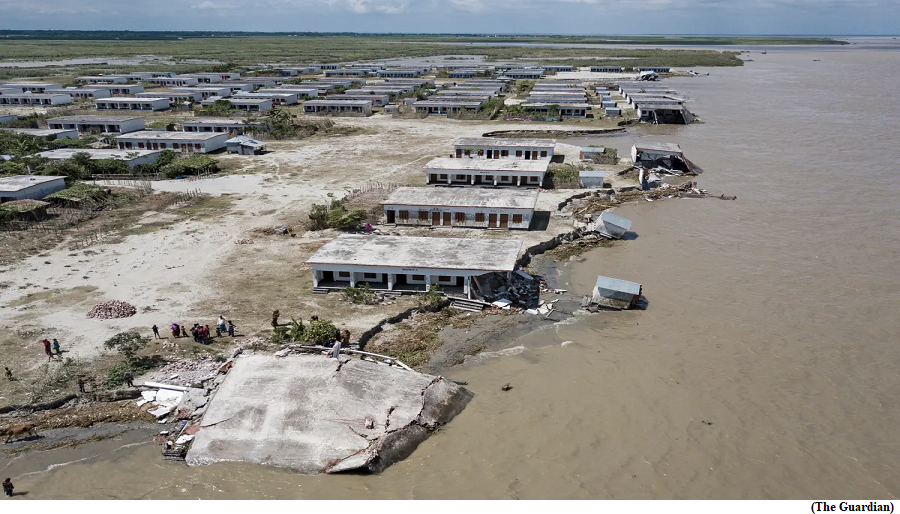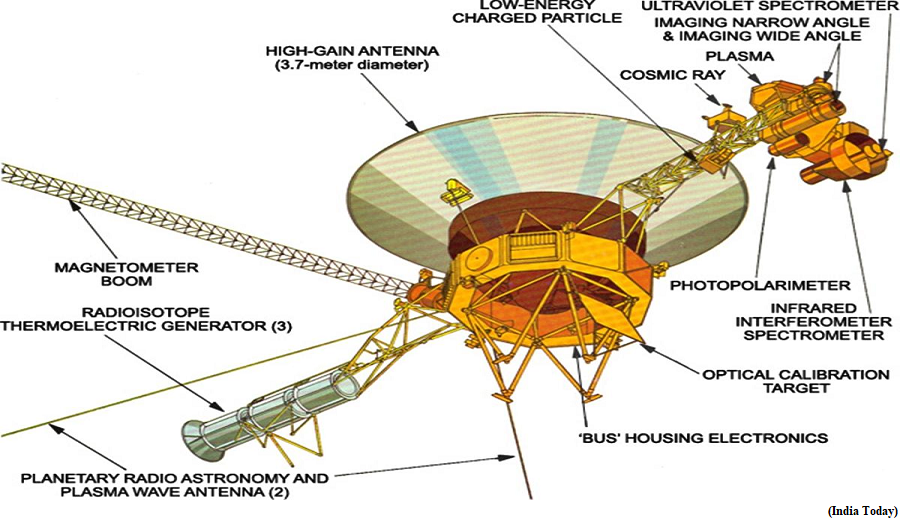The threat of rising sea levels (GS Paper 3, Environment)

Why in news?
- Recently, the World Meteorological Organisation (WMO) published its new report entitled ‘State of the Global Climate 2022’.
Details:
- As per the report, the world’s sea level is rising at an unprecedented rate, portending potentially disastrous consequences for the weather, agriculture, the extant groundwater crisis, and social disparities.
- Along with accelerating sea-level rise, it focused on a consistent rise in global temperatures, record-breaking increases in the concentration of greenhouse gases as well as glacier loss, sustained drought-like conditions in East Africa, record rainfall in Pakistan, and unprecedented heatwaves that struck Europe and China in 2022.
- While the sea-level rise is one of several compounding disasters, it also merits individual attention for the unique crises it can precipitate, especially for coastal areas, the communities there that depend on life in the sea, and its ability to render the loss of land.
How much is the sea rising?
- The rate of Global Mean Sea-Level (GSML) rise has doubled between the first decade of the satellite record and the last.
- Since the 1990s, scientists have been measuring sea-level rise using satellite altimeters. These instruments send radar pulses to the sea surface and measure the time they take to get back and the change in their intensity. The higher the sea level, the faster and stronger the return signal.
- According to the WMO report, the sea level has been rising in the three decades for which satellite altimeter data is available (1993-2022). But, while the rate of sea-level rise was 2.27 mm/year in 1993-2002, it shot up to 4.62 mm/year in 2013-2022.
What causes accelerated sea-level rise?
Ocean Heat Content:
- According to the report, in 2005-2019, loss of glaciers and ice sheets contributed 36% to the GSML rise. Ocean warming contributed 55%, and changes in the storage of land water contributed less than 10%.
- As increasing concentrations of carbon dioxide and other greenhouse gases drive global warming, 90% of the ‘extra’ heat is stored in the oceans. This leads to ocean warming.
- And as the ocean heats up, it undergoes thermal expansion, which in turn leads to a rise in the GSML. One measure of ocean warming is the Ocean Heat Content (OHC).
- As per the report, OHC measures in 2022 touched a new record.
Cryosphere:
What problems will sea-level rise cause?
Coastal communities:
- As rising seas swallow more of the land cover, particularly in coastal areas, coastal communities will face an “acute shortage of land for human use”.
- This land crunch will mean that those who are better off will be able to cope better than marginalised groups, leading to an increase in social disparities between people living in coastal areas.
Cyclones:
- The weather formations such as cyclones are known to typically originate in the open seas.
- As the GSML continues to rise, along with a rise in ocean temperatures, the chances of cyclones could increase, affecting coastal communities and leading to large economic liabilities for tropical countries such as India and South Africa, which have high population densities.
- Besides this, the WMO report says that South Africa was affected by five cyclones in over two months in 2022, leading to the displacement of “hundreds of thousands of people”.
Groundwater crisis:
- As the GSML continues to rise, more sea water could seep into the ground, leading to the groundwater turning more and more saline.
- This, in turn, can exacerbate water crises in coastal areas as well as agriculture in adjacent regions.
How will sea-level rise affect societies:
- For example, in the Sundarbans delta in West Bengal, the world’s largest mangrove area, rising sea levels and coastal erosion, due to loss of land and sediment from coastal areas, has left more islands submerged under water, and that, in turn, has forced members of local communities to migrate.
- Since the lives of coastal communities, including their economic activities, is tied intricately with the coastal ecosystem, changes in the coastal ecosystem as a result of GSML rise will further endanger the socio-economic stability of these communities.
- Indeed, a combination of these forces having increased child trafficking in the Sundarbans area has already been documented.
Way Forward:
- Thus, it is crucial that reports such as the WMO’s ‘State of the Global Climate 2022’ continue to generate and accumulate data on climate change.
Centre releases SOPs under the Production Linked Incentive scheme for the automotive sector
(GS Paper 3, Economy)
Why in news?
- The Ministry of Heavy Industries recently announced the release of SOPs under the PLI Auto scheme to testing agencies.
- With this, the applicants under the scheme can now submit their applications for the testing and certification of AAT products (both OEMs and components), which will help them qualify for incentives under the PLI Auto scheme.

PLI-AUTO Scheme:
- The Ministry of Heavy Industries (MHI) notified the Production Linked Incentive (PLI) Scheme for Automobile and Auto Component Industry in India (PLI-AUTO Scheme or the Scheme) on September 23, 2021, with a budgetary outlay of 25,938 crores.
- The PLI-Auto Scheme proposes financial incentives to boost domestic manufacturing of advanced automotive technology (AAT) products and attract investments in the automotive manufacturing value chain.
- The scheme has two parts:
- Champion OEM, which will make electric or hydrogen-powered vehicles, and
- Component Champions, which will make high-value and high-tech components.
The objectives of the PLI Scheme:
- The key objectives of the Production Linked Incentive (PLI) Scheme for Automobiles and Auto Components are to provide financial incentives to boost domestic manufacturing of advanced automotive technology products and attract investments in the automotive manufacturing value chain.
- Its prime objectives include overcoming cost disabilities, creating economies of scale, and building a robust supply chain in areas of advanced automotive technology products.
- The scheme also aims to generate employment in the country.
- To facilitate the automobile industry's move up the value chain into higher-value-added products
Domestic Value Addition (DVA):
- According to the scheme guidelines, applicants must achieve a DVA of 50% to claim incentives under the scheme. The auto companies and component makers are required to calculate and present the DVA across their supply chain and present these details to the testing agencies.
- This is being done to promote the Make in India campaign and boost domestic manufacturing of advanced automotive products.
Committee for making SOP:
- A committee headed by Director ARAI Pune was constituted with members comprising all testing agencies, viz., iCAT Manesar, NATRAX, Pune, GARC Chennai, and IFCI (PMA for PLI Auto Scheme), to make an SOP for calculating DVA, or domestic value addition.
- Accordingly, with this sharing of knowledge and views among the various stakeholders, the committee drafted the SOP after deliberating on all the suggestions received from the stakeholders. Consultations were held with all 85 applicants for the PLI scheme.
- These include 18 OEMs and 67 auto component manufacturing companies. The list of these companies is attached.
Ease of doing business:
- The Government of India, with a view to promoting ease of doing business, has taken care to devise simple procedures with the minimum paperwork needed to file an application under the PLI scheme.
- A direct supplier to an OEM is called a "tier 1 supplier. Tier 1 suppliers are known as Tier 2 suppliers, and so on. The information with regard to imports up to the Tier 3 level has to be authenticated by the applicants up to the Tier 1 level only. However, no documents up to Tier 3 will be required to be submitted at the time of filing the application.
- The declarations submitted by the applicants will be adequate for most of the requirements under the scheme.
- This will reduce the compliance burden on the applicants and promote faster applications and the disbursal of incentives under the scheme.
Power to remove difficulties:
- In case there are unforeseen circumstances preventing compliance with all provisions contained in the SOP, the testing agencies have been given the power to relax the provisions of the SOP.
- This will enable a flexible approach to the resolution of issues that may arise in the complex supply chain of the automotive industry.
Voyager 2 gets a boost to keep doing science till 2026 outside our Solar System
(GS Paper 3, Science and Technology)
Why in news?

Details:
- It takes a signal from Earth over 18 hours to reach Voyager-2, which is 20 billion kilometers away from after being launched in 1977.
- The new plan will keep the science instruments turned on for a few more years, which were to shut down in 2023.
Power supply:
- Engineers on Earth have commanded Voyager-2 to begin using a small reservoir of backup power set aside as part of an onboard safety mechanism.
- The spacecraft's power supply has been diminishing after being in space for over 45 years as it continues to travel deep into interstellar space.
- Powered by a miniature nuclear reactor, Voyager-2, along with its twin Voyager-1, is exploring the region outside the heliosphere, the protective bubble of the Sun, after which our star loses its influence. The two probes are the only satellites to venture outside the Solar System.
RTGs:
Way Forward:
- With the new boost, the science instruments on Voyager are set to get a new lease of life and will continue to shed more light into the world we have never ventured before.
About Voyager Mission:
- Voyager 1 departed Earth on 5 September 1977, a few days after Voyager 2 and left solar system in 2013.
- The mission objective of the Voyager Interstellar Mission (VIM) is to extend the NASA exploration of the solar system beyond the neighborhood of the outer planets to the outer limits of the Sun’s sphere of influence, and possibly beyond.
Achievements:




